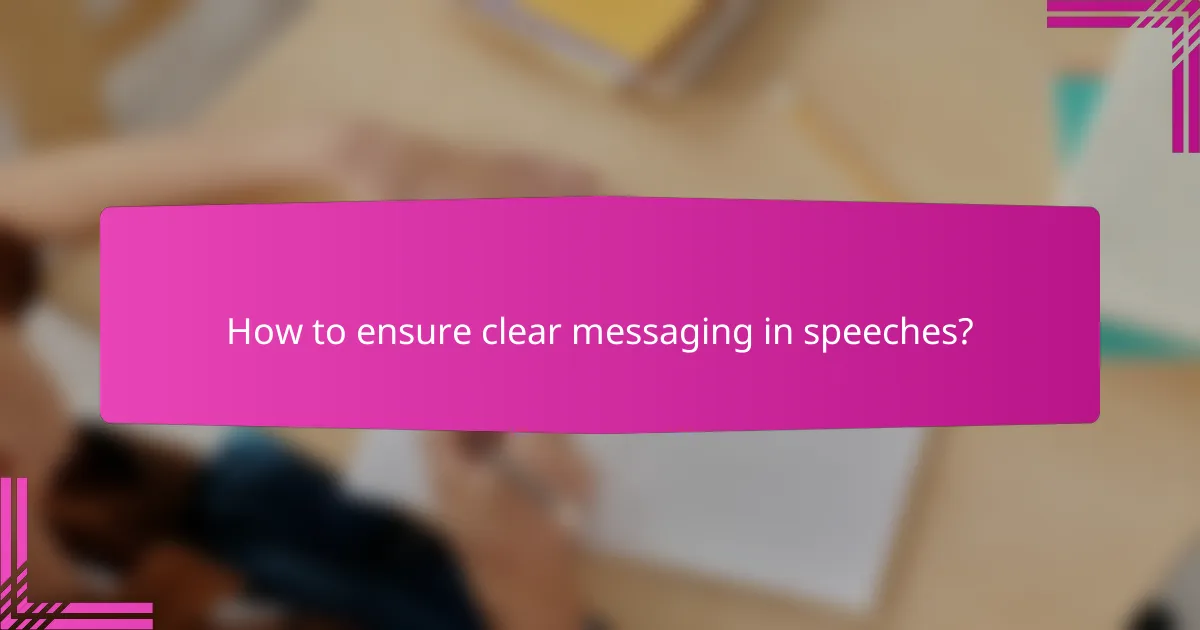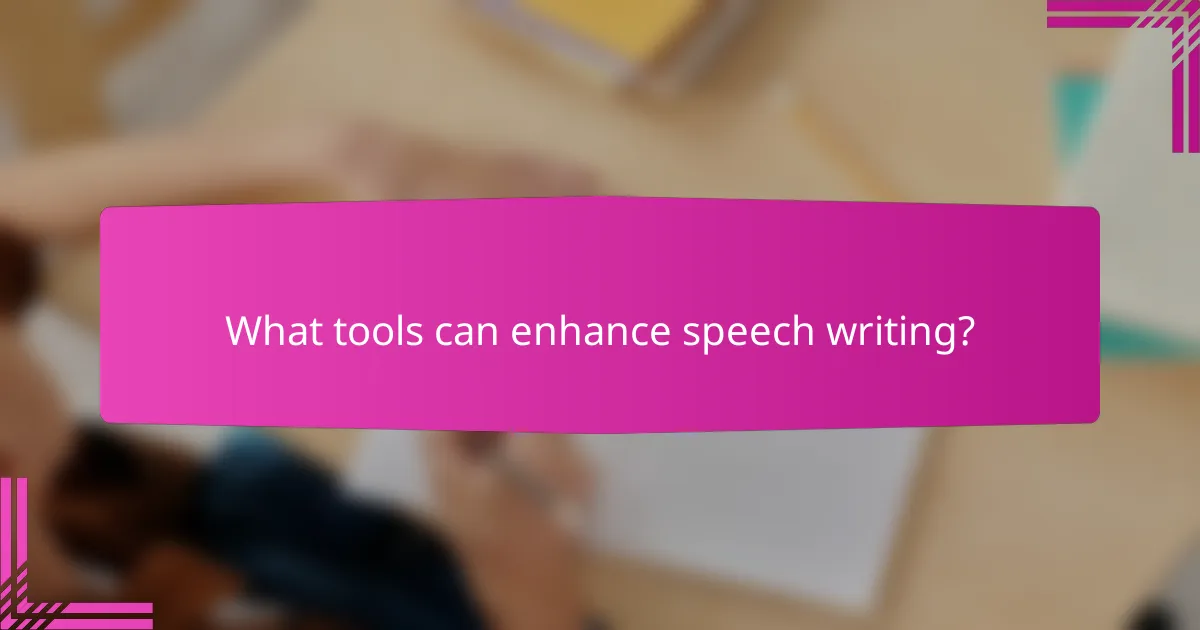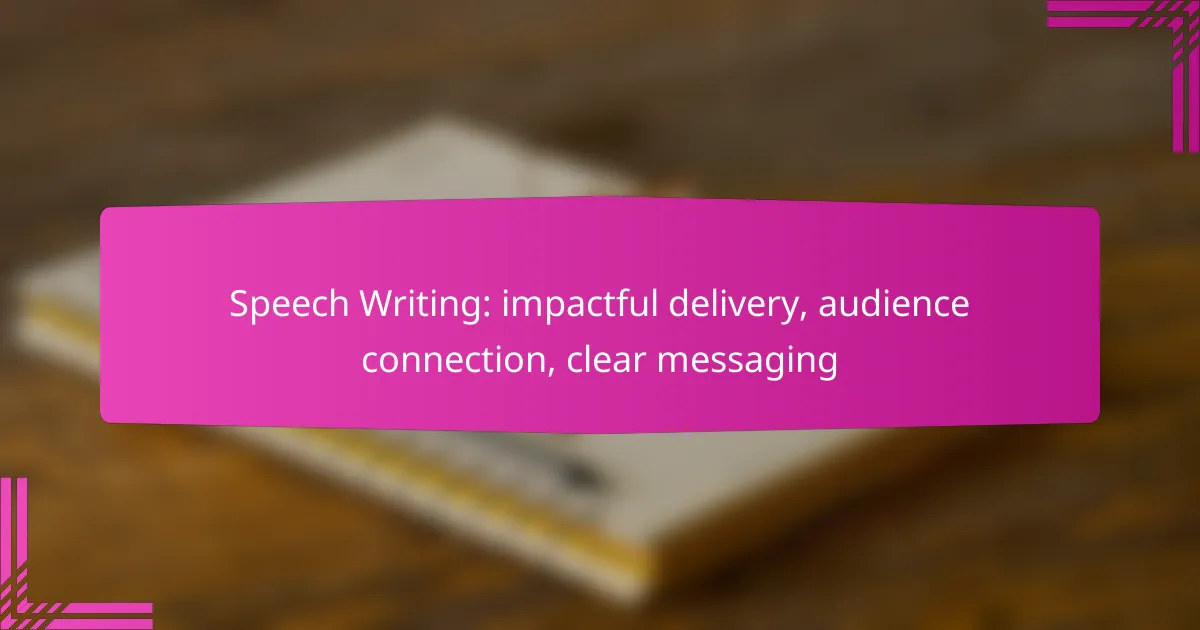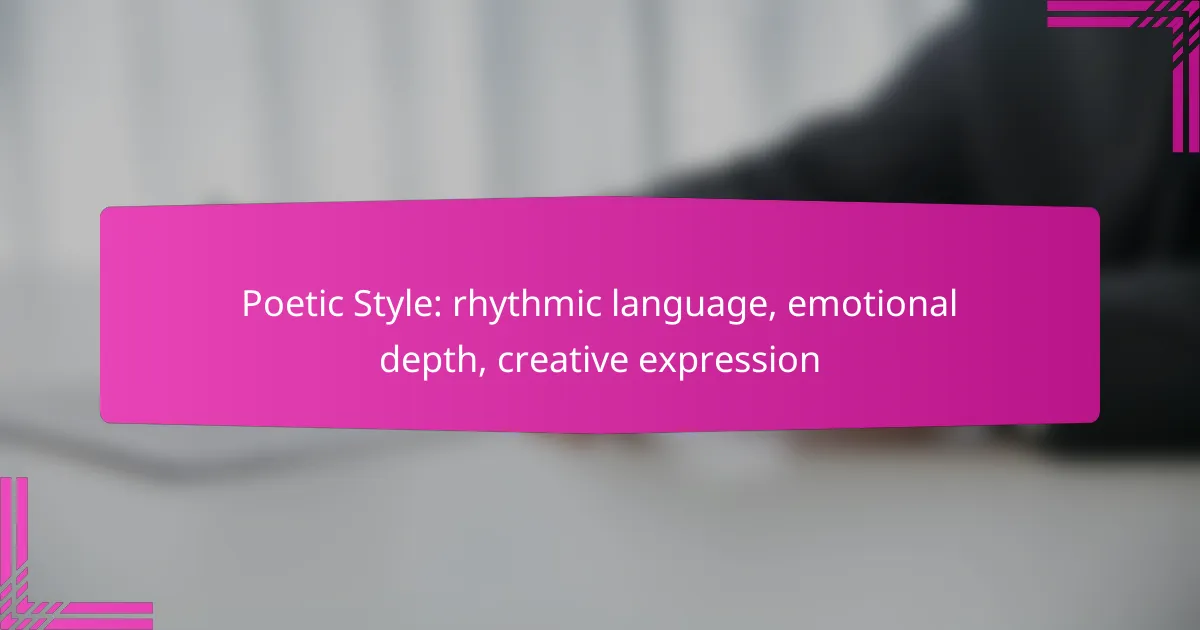Crafting an impactful speech requires a clear message that resonates with your audience, enhanced by engaging delivery and relatable storytelling. By understanding your audience’s demographics and incorporating local references, you can forge a stronger connection that makes your message memorable. Focus on conveying a single, strong idea using straightforward language and logical organization to ensure clarity and effectiveness in your delivery.

How to write an impactful speech in Australia?
To write an impactful speech in Australia, focus on crafting a clear message that resonates with your audience while employing storytelling techniques. Engaging delivery and local references can significantly enhance the connection with listeners.
Focus on storytelling
Storytelling is a powerful tool in speech writing that helps to create emotional connections. Begin with a personal anecdote or a relatable story that ties into your main message, making it easier for the audience to engage with your topic.
Consider structuring your speech like a narrative, with a clear beginning, middle, and end. This approach not only maintains interest but also reinforces your key points through memorable examples.
Use persuasive language
Persuasive language is essential for motivating your audience to take action or adopt your viewpoint. Use strong, vivid words and phrases that evoke emotions and paint a clear picture of your ideas.
Avoid jargon and complex terminology that may alienate listeners. Instead, opt for simple, direct language that is easy to understand, ensuring your message is accessible to everyone in the audience.
Incorporate local references
Incorporating local references can make your speech more relatable and relevant to an Australian audience. Mention local events, cultural icons, or current issues that resonate with your listeners to create a sense of familiarity.
Using Australian slang or idioms can also enhance connection, but be cautious not to overdo it. Ensure that your references are appropriate and enhance your message rather than distract from it.
Practice delivery techniques
Effective delivery techniques can significantly impact how your speech is received. Practice your pacing, tone, and volume to ensure clarity and engagement throughout your presentation.
Consider recording yourself or rehearsing in front of a trusted friend to receive constructive feedback. Focus on body language and eye contact, as these non-verbal cues can enhance your connection with the audience.
Engage with the audience
Engaging with your audience is crucial for maintaining their interest and making your speech memorable. Ask rhetorical questions or include interactive elements, such as polls or brief discussions, to encourage participation.
Be attentive to audience reactions and adjust your delivery accordingly. Acknowledging their responses can create a more dynamic atmosphere and foster a sense of community during your speech.

What are key elements of audience connection?
Key elements of audience connection include understanding the audience’s demographics, utilizing relatable anecdotes, and encouraging participation. These factors help create a bond between the speaker and the audience, making the message more impactful and memorable.
Understand audience demographics
Understanding audience demographics involves recognizing the age, gender, cultural background, and interests of your listeners. This knowledge allows you to tailor your message to resonate with their experiences and expectations.
For instance, a speech aimed at young professionals might incorporate contemporary references and technology, while a presentation for retirees may focus on nostalgia and traditional values. Researching your audience beforehand can significantly enhance engagement.
Utilize relatable anecdotes
Using relatable anecdotes can bridge the gap between the speaker and the audience. Personal stories or experiences that reflect common challenges or successes can evoke empathy and make your message more relatable.
For example, sharing a story about overcoming a professional setback can inspire listeners who may face similar challenges. Ensure that your anecdotes are concise and relevant to the main message to maintain focus and clarity.
Encourage audience participation
Encouraging audience participation fosters a sense of involvement and connection. This can be achieved through questions, polls, or interactive activities that invite feedback and engagement.
For instance, asking the audience to share their thoughts on a topic or conducting a quick poll can create a dynamic atmosphere. Be mindful to create a comfortable environment where participants feel valued and willing to contribute.

How to ensure clear messaging in speeches?
To ensure clear messaging in speeches, focus on conveying a single, strong idea that resonates with your audience. This involves defining your core message, using straightforward language, and organizing your speech logically to enhance understanding.
Define core message
Your core message is the central idea you want your audience to remember. Start by identifying the main takeaway you wish to convey, which should be specific and relevant to your audience’s interests or needs.
Consider framing your core message in one concise sentence. This clarity helps you stay focused and ensures that every part of your speech supports this key point, making it easier for listeners to grasp and retain your message.
Use simple language
Using simple language enhances clarity and keeps your audience engaged. Avoid jargon and complex vocabulary that may confuse listeners; instead, opt for everyday words that convey your ideas effectively.
When crafting your speech, aim for short sentences and active voice. This approach not only makes your message more accessible but also helps maintain the audience’s attention throughout your delivery.
Structure speech logically
A logical structure is crucial for clear messaging in speeches. Organize your content into a clear beginning, middle, and end, ensuring that each section flows smoothly into the next.
Consider using an outline to map out your main points and supporting details. This helps you maintain a coherent narrative and allows your audience to follow your argument easily. Common structures include chronological, problem-solution, or thematic arrangements, depending on your topic.

What are effective delivery techniques?
Effective delivery techniques enhance a speaker’s ability to connect with the audience and convey messages clearly. These techniques include maintaining eye contact, varying vocal tone, and using body language effectively to engage listeners and reinforce key points.
Maintain eye contact
Maintaining eye contact is crucial for establishing a connection with your audience. It conveys confidence and helps to engage listeners, making them feel included in the conversation. Aim to make eye contact with different sections of the audience throughout your speech to create a sense of intimacy.
However, avoid staring at any one person for too long, as this can create discomfort. A good rule of thumb is to hold eye contact for a few seconds before shifting your gaze to another part of the room.
Vary vocal tone
Varying your vocal tone keeps the audience’s attention and emphasizes key points. A monotone delivery can lead to disengagement, while changes in pitch, volume, and pace can convey emotion and urgency. Practice using a range of tones to highlight important ideas and maintain interest.
For example, slowing down your speech during critical moments can create suspense, while raising your voice slightly can signal excitement or enthusiasm. Be mindful of your natural speaking style and incorporate variations that feel authentic to you.
Use body language effectively
Effective body language complements your verbal message and reinforces your points. Gestures, facial expressions, and posture all play a role in how your message is received. Use open gestures to invite connection and avoid crossing your arms, which can appear defensive.
Additionally, consider your movement on stage. Purposeful movement can help emphasize points, but excessive pacing may distract your audience. Practice your speech with intentional body language to ensure it aligns with your message and enhances your delivery.

What tools can enhance speech writing?
Several tools can significantly improve the quality of speech writing by enhancing clarity, engagement, and overall impact. Utilizing editing software, visual design platforms, and dedicated writing applications can streamline the process and elevate the final delivery.
Grammarly for editing
Grammarly is a powerful editing tool that helps refine your speech by correcting grammar, punctuation, and style issues. It provides real-time feedback, ensuring that your messaging is clear and professional.
To maximize its effectiveness, use Grammarly to check your speech multiple times, focusing on different aspects like tone and readability. This iterative approach can help you catch errors you might overlook initially.
Canva for visual aids
Canva is an excellent platform for creating visual aids that can complement your speech. Engaging visuals can help reinforce your message and keep the audience’s attention, making complex ideas easier to understand.
When using Canva, consider designing slides or infographics that summarize key points. Aim for a clean layout with minimal text and impactful images to enhance your presentation without overwhelming your audience.
Speech writing software
Dedicated speech writing software, such as Final Draft or Celtx, offers features tailored for crafting speeches. These tools often include templates, formatting options, and collaboration features that streamline the writing process.
When choosing speech writing software, look for user-friendly interfaces and features that allow for easy editing and organization of your content. This can save time and help maintain focus on your core message.

What are common mistakes in speech writing?
Common mistakes in speech writing include lack of clarity, poor audience engagement, and ineffective structure. These pitfalls can lead to a disconnection with listeners and a failure to convey the intended message.
Poor Structure
A speech without a clear structure can confuse the audience. It’s essential to have a logical flow, typically starting with an introduction, followed by the main points, and concluding with a strong closing statement. A well-organized speech helps listeners follow along and retain information.
Overly Complex Language
Using jargon or overly complex language can alienate the audience. Aim for simple, straightforward language that everyone can understand. For instance, instead of saying “utilize,” simply say “use.” This makes your message more accessible and relatable.
Lack of Audience Engagement
Failing to engage the audience can result in a lack of interest. Incorporate questions, anecdotes, or relatable examples to draw listeners in. For example, asking a rhetorical question at the beginning can pique curiosity and encourage active listening.
Neglecting the Purpose
Every speech should have a clear purpose, whether to inform, persuade, or entertain. Neglecting this can lead to mixed messages. Before writing, define the main goal and ensure every part of the speech aligns with this objective.
Ignoring Time Constraints
Exceeding time limits can frustrate the audience and diminish the impact of your message. Practice your speech to ensure it fits within the allotted time. A good rule of thumb is to aim for about 1-2 minutes per main point, depending on the total duration.



